For most small business owners on Instagram, creating and launching effective Instagram Story Ads still seem overwhelming and out of reach. How to shoot the Ad? How do you launch the Ad? How much money should you spend? How do you know if it’s set up correctly? I had the same questions when I began my Instagram Story Ads journey too but, don’t worry, although they can be a deeply complex science, there are also ways for anyone to create them quickly, simply, cheaply and effectively.
In my case, after being shown the ropes by the always-sharp Finn Thormeier, I was able to reach over 4.3 million people on Instagram, grow over 4K followers, increased my website traffic by 100% (year to year), and earn over $450 extra dollars in sales with a budget of only $462 in a month.
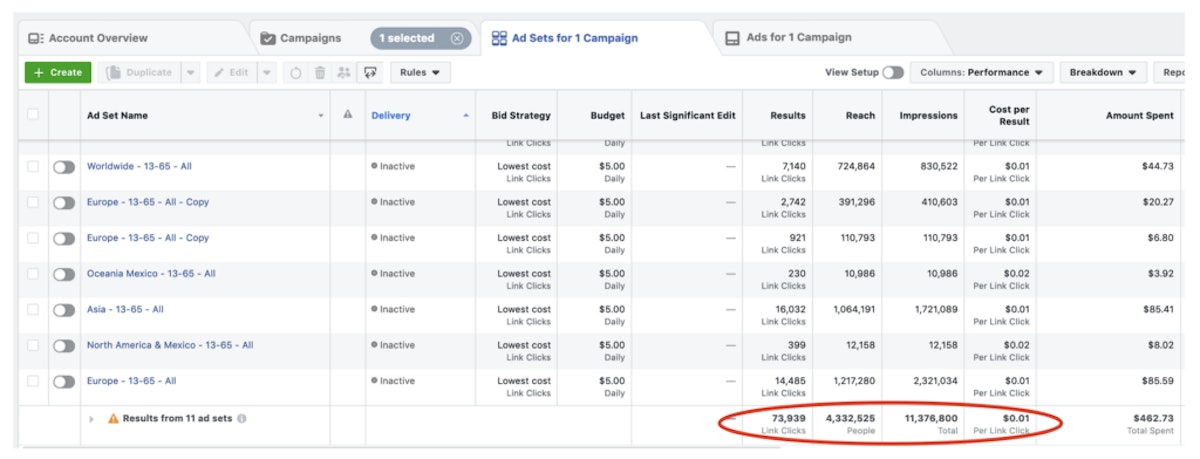
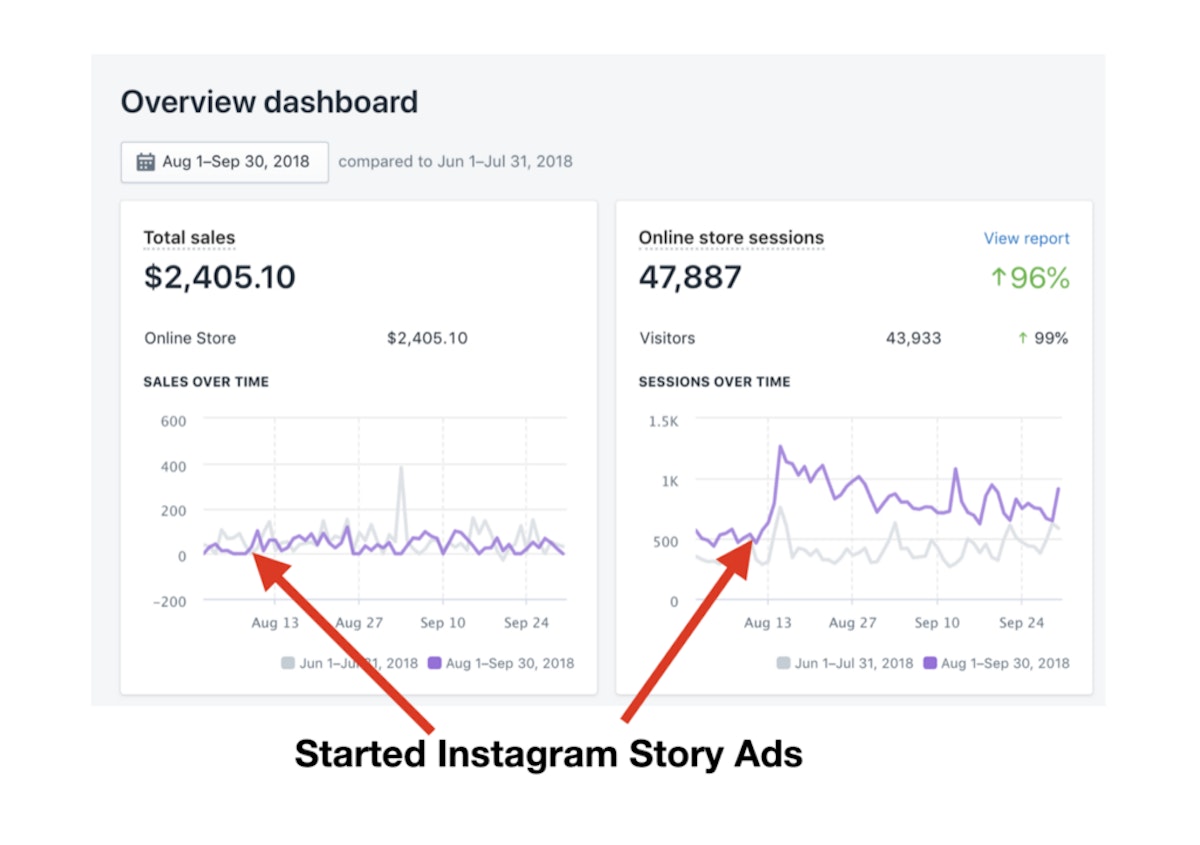
I make a living from my Instagram accounts so figuring out a way to be able to control the traffic and sales I can generate is very important for me, especially given how saturated my niche is and the constant fluctuations of the Instagram algorithm.
I’m sure these results aren’t as lucrative as what the most experienced Facebook Ads experts out there can generate, but given that I had no experience or big budget, it was one of the most effective Instagram growth options I’ve ever tested on my accounts.
More importantly, it’s a process that’s easy to replicate (which means you can do it too) and the results were much more effective in comparison to having spent that same amount of money on regular Instagram home feed Sponsored Posts (which most small business owners who run Instagram Ads focus on at the moment).
Here’s how I did it…
The process of creating your first effective Instagram Story Ad can be broken down into 3 main steps:
1. Make sure you have a differentiated Instagram account with “sticky” content:
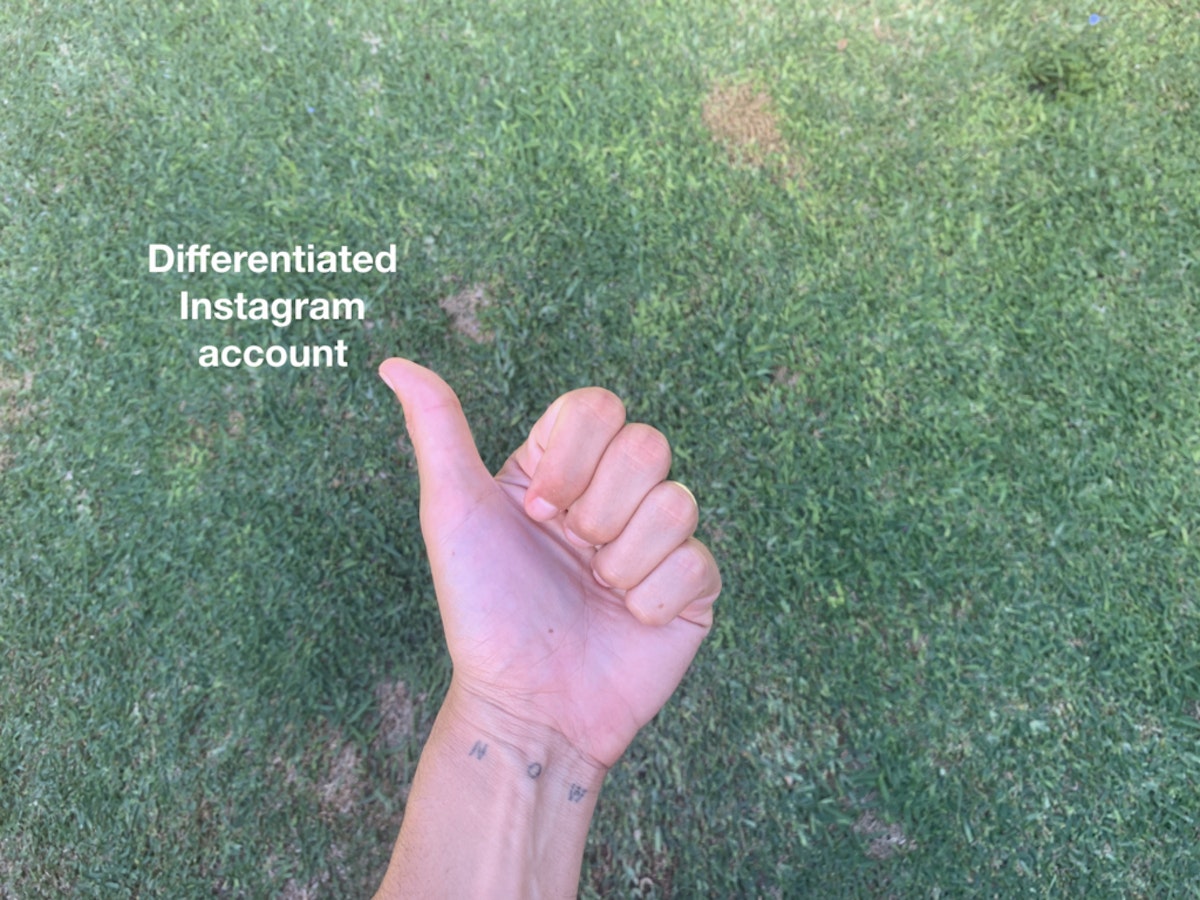
Before you begin running any Ads, it’s important to first make sure you have a differentiated Instagram account with sticky content. You can spend all the money in the world bringing people to your account through Ads, but unless you have differentiated “sticky” content, all of the people you bring will likely just see your page and leave. You’ll be wasting your money (as many people who run Ads do).

Here’s an example of how differentiated content and a visually distinctive grid generates growth. The account on the left @ceramics_monthly creates the same type of content as the account on the right @potteryforall (featuring ceramic artists on Instagram) but the account on the right grows organically at 3x the pace because it’s focused on curating a great grid with great photos. Unless you take the time and effort to create great content and grid layout, you’re not likely to grow as fast as other accounts in your niche. Planning and automating your posts ahead of time is a good place to start.
Although there are many ways of creating a differentiated Instagram account, following the principles in this article will increase the likelihood of actually accomplishing it. In short, it’s all about creating the most engaging content in your niche by understanding which of your posts create the most value and clearly showcasing them through a visually differentiated grid.
If your account reaches a point where it's growing at a steady pace without Sponsored Posts or automation, you’re likely differentiated enough to generate great results by bringing more eyes to your account through Instagram Story Ads. Conversely, if your account doesn’t grow at all by itself, it’s likely that it’s not differentiated enough to grow through Instagram Story Ads either.
2. Create an Instagram Story Ad that doesn’t feel like an “Ad”.
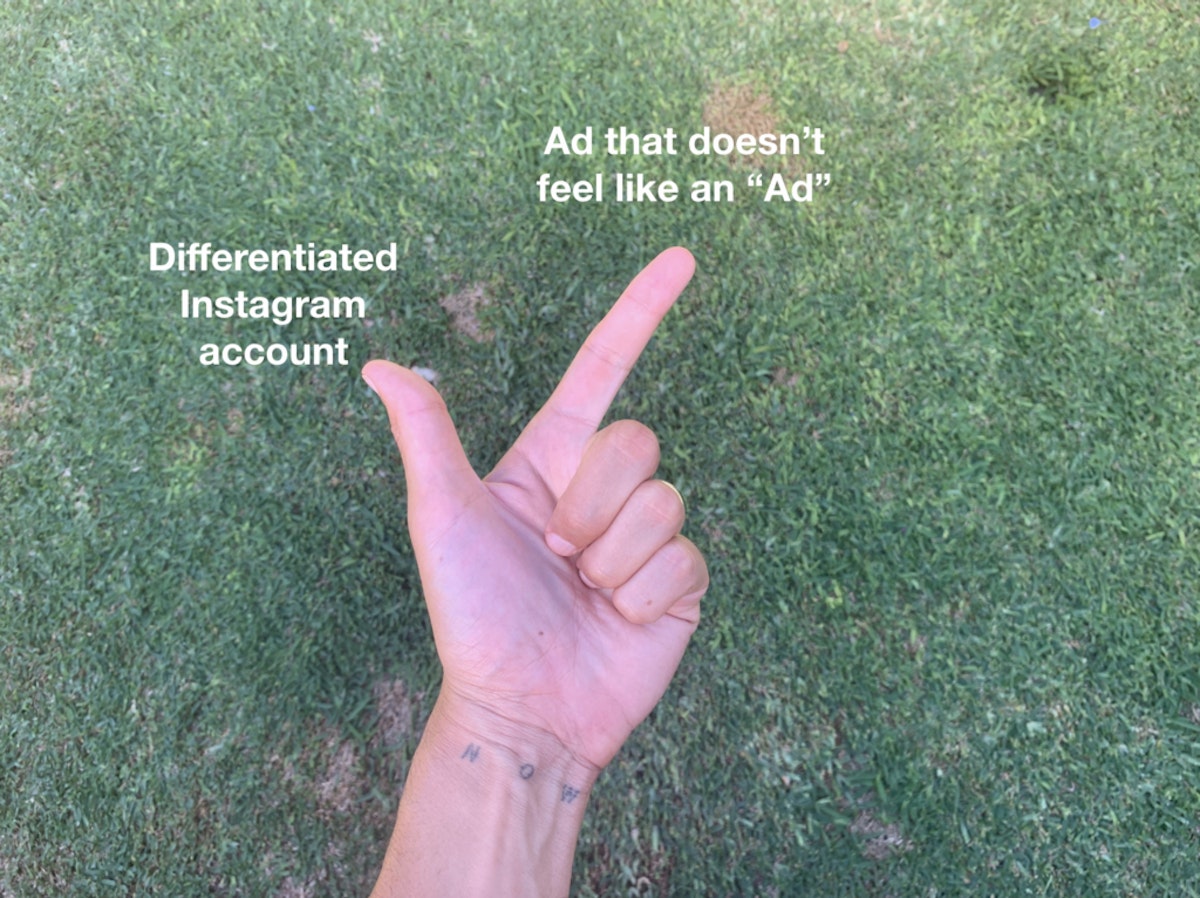
We’ve all seen “Ads” since the day we were born and most of us have a pre-conceived idea of what “Advertising” looks like. It usually involves slick graphics and photos, sharp, catchy text and very clear visual communication of exactly what we’re being sold. When it comes to Instagram Story Ads, they usually look like something along these lines:
Unfortunately given the general lack of information regarding what type of Ads are effective on Instagram Stories, as well as the wide availability of Instagram video template tools that thrive on content like the video above, most small businesses (and big brands) fall into the trap of thinking this is what great performing Ads should look like.
This shared belief means most Instagram Ads have the same aesthetic and format. Very few of them feel sincere and differentiated, and consequently, very few of them work. If you’re a small business owner with a minimal budget, wasting your money on Ads that don’t work is a serious problem.
The good news is, creating an effective Instagram Story Ad doesn't require any fancy graphics apps or Advertising know-how at all. The trick is actually making your Ad feel like it’s not an Ad. How do I know? I tested it. After testing multiple types of Instagram Story Ad formats and videos, this is the one that by far got the best results for me and something similar is likely to get great results for you too:
As you can tell, there’s a huge difference between this video and most “Ads”. Why did it perform so well? Because it doesn’t feel like an Ad. It feels like a regular story you might see from a friend or someone you follow and because of that, people pay attention to it.
Here’s how you can make one too:
- Instagram Ads are limited to 15 seconds: Before we get into the nitty-gritty, it’s important to know this time limit because you have to plan your shoot around it. Below are timings that are a generally good rule of thumb about how to break it down the structure of your Ad.
- Second 0:00–0:02 — Capture your audience’s attention: People usually decide whether they want to see more of a story or move on to the next one within the first few seconds of watching it. This means you have to start your videos with something that grabs people’s attention. What gets people’s attention greatly depends on what content they are used to seeing, so the more in-tune you are to what your audience will respond to, the more likely it is that you’ll be able to start your video in a way that will interest them to watch more. In my case, it was starting the Ad with a shot of my pin-covered backpack (watch the video above to see it).
- Second 0:02–0:09 — Clearly communicate your value proposition in an energetic and differentiated way: Once you’ve captured your audience’s attention, explain why it’s worthwhile for them to continue paying attention to your video and swipe up. Ask yourself: “Why would people seriously perceive enough value in what my Ad shows or says to want to watch it to the end?” If you’ve used Instagram before you know that it’s rare to watch one story until the end unless it’s super interesting, so try to make your Ad really interesting if you want it to perform well! Presenting your content energetically and in a differentiated way really helps. Even if it’s the most valuable content, if it’s delivered in a boring way, no one will care. In my case, I just focused on being very energetic while I told my audience that I show people how to make their own enamel pins. Not many other accounts on Instagram offered that at the time this Ad ran, so it stood out of the crowd.
- Second 0:09–0:12 — Call to action: You’ve captured people’s attention and communicated your value enough for them to watch through to second 9… Now what? If you don’t specifically tell your audience what action you’d like them to take at this point, most of them will just tap right and move on to the next story. The path of least resistance for most audiences will be to swipe up. Don’t ask them to buy your products or your course that will make them millionaires… Just ask them to swipe up. They’ll land on your Instagram page (more on that later), then your Instagram bio and content can do the selling for you.
- Second 0:12–0:15 — Dedicated call to action screen: In most cases, asking people to swipe up won’t be enough, so leave a 3-second screen at the end that shows nothing except the prompt to “Swipe up” (see the video above for an example). Why? Unless you leave a few seconds where people are given the empty space to swipe up, most of them will just think there’s more of an Ad to watch and they’ll simply watch for the 15 seconds without actually swiping up. Once the 15 seconds pass, a new story appears and the likelihood that they’ll go back to your Ad to swipe up is much smaller in comparison to leaving 3 seconds at the end that gives them time to swipe up. Believe me, this is very important.
- Include text captions: When it comes to minor technical elements of the video itself, the most important one is to make sure your Ad has readable captions of what you’re saying. Most users mute their Instagram stories when swiping through them so unless you include captions, people won’t know what you're saying and that increases the likelihood that they’ll just tap right and move on to the next story. In my case, I used Videorama to include simple text captions at the bottom and a black screen with a call to action and music at the end.
- Make it feel like it’s not an “Ad”: This is the most subjective and important element of the process. Don’t make your Ad feel like an “Ad”! What feels or doesn’t feel like an Ad depends on the type of Ads that are popular on Instagram at the time you read this article, so the best way to figure out what does and doesn’t feel like an Ad is to spend a lot of time on your Instagram stories and note what the Ads you’re served look and feel like. Then do the opposite. Create something that doesn’t look and feel like that. When I ran my well-performing Ad, all Ads on Instagram looked like this, so a casual, more personal Ad really stood out. I shot it on an iPhone in portrait mode. I shot it like I would shoot a “regular” story (no big production) and I just told people what value I think I create in their lives, asking them to swipe up and follow me if they are interested. The key here is to not sellsomething. You are creative! Come up with a way to make people interested in what you do without telling them to BUY.
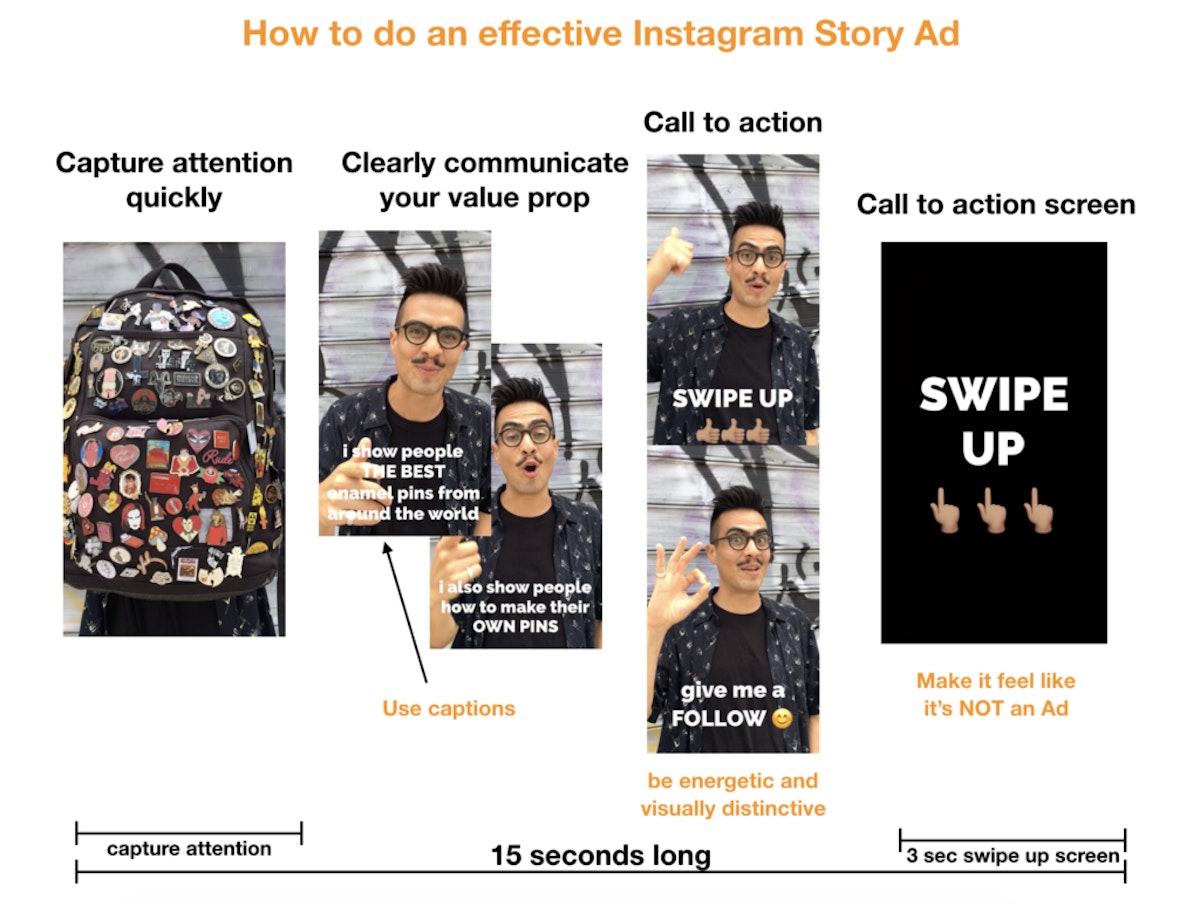
3. Launch your Ad within the widest applicable audience to test its performance cheaply:
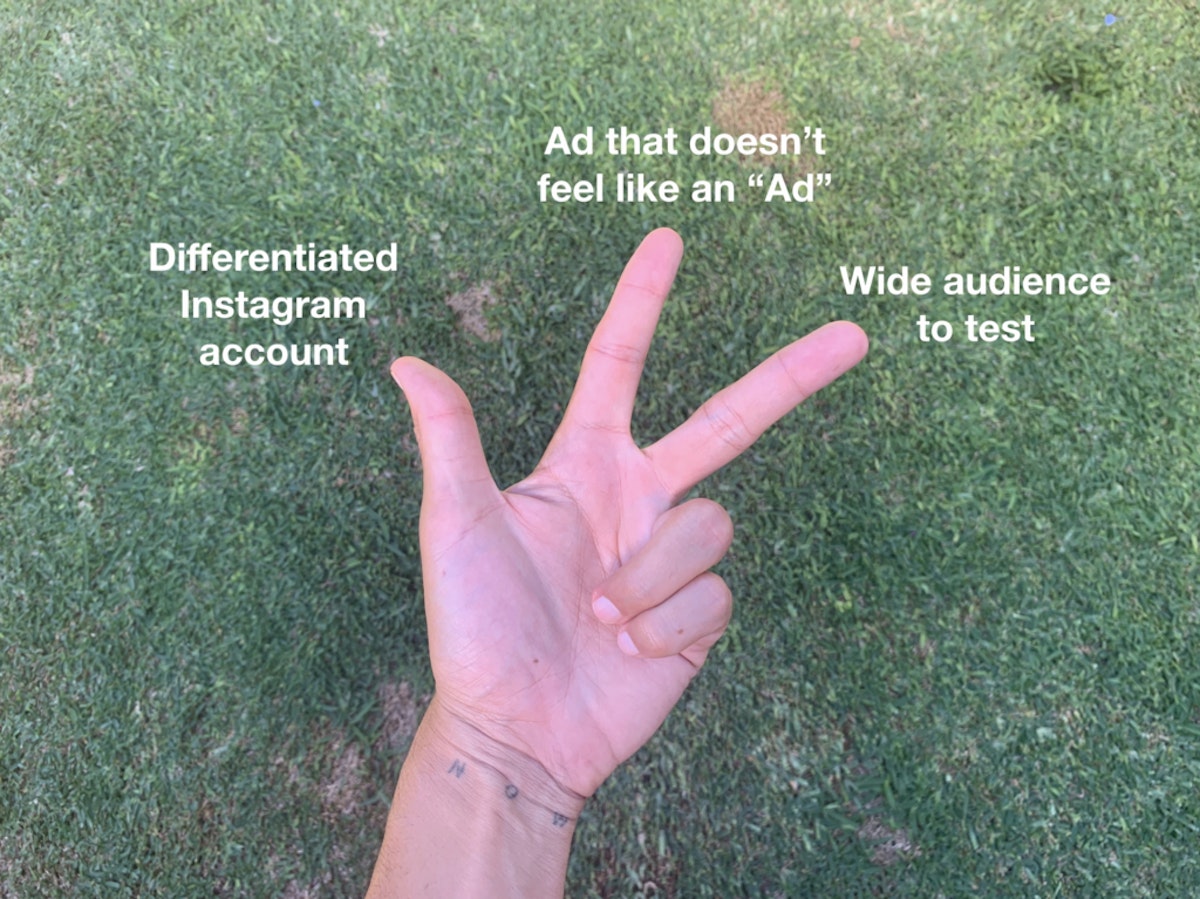
Once you have a differentiated account with sticky content and you’ve created an Instagram story Ad that doesn’t feel like an “Ad”, you can finally launch and measure if it works.
I’ve learned from experience that unless you’re an experienced Facebook Ads manager, it’s very unlikely that you’ll get positive returns from an Instagram Story Ad if you choose to target a specific, niche Custom Audience based on demographics. That’s because effectively reaching your target audience requires a much, much deeper knowledge of audience targeting and the Facebook Ads tool specifically. So unless you’re willing to put in the time and money required to learn that skill proficiently, you’re much more likely to see positive results from your Story Ad by focusing on your widest applicable audience.

Long story short, the Instagram Ads Custom Audience targeting works through supply and demand. Niche, demographics-based audiences tend to be limited but have a large demand, which increases the price of serving Ads to them. By focusing on the widest applicable audience and choosing to be charged by link click (more on that later) you are focusing on a Custom Audience segment that has a comparably lower demand and this allows you to reach a much larger number of people at a lower price. By being charged by link click, you’re only paying for the people out of that large audience who connect with your Ad and the cost per link click tends to be much lower.
If you don’t believe me, run two Ad sets (one with a niche, demographics-based custom audience and one with the widest applicable custom audience) and measure which one has the lowest cost per click as well as the larger amount of follower growth and sales.
If through this test you notice that your niche custom target audience performs best, great! If it doesn’t, here’s the exact step by step process I use to run my Ads to a wide audience:
- First, make sure you’re set up as a Business Instagram account. Once you’ve gone through that process, go to your Ads manager dashboard in your Business Manager profile on Facebook and click on the “Create” button to begin the set-up process.
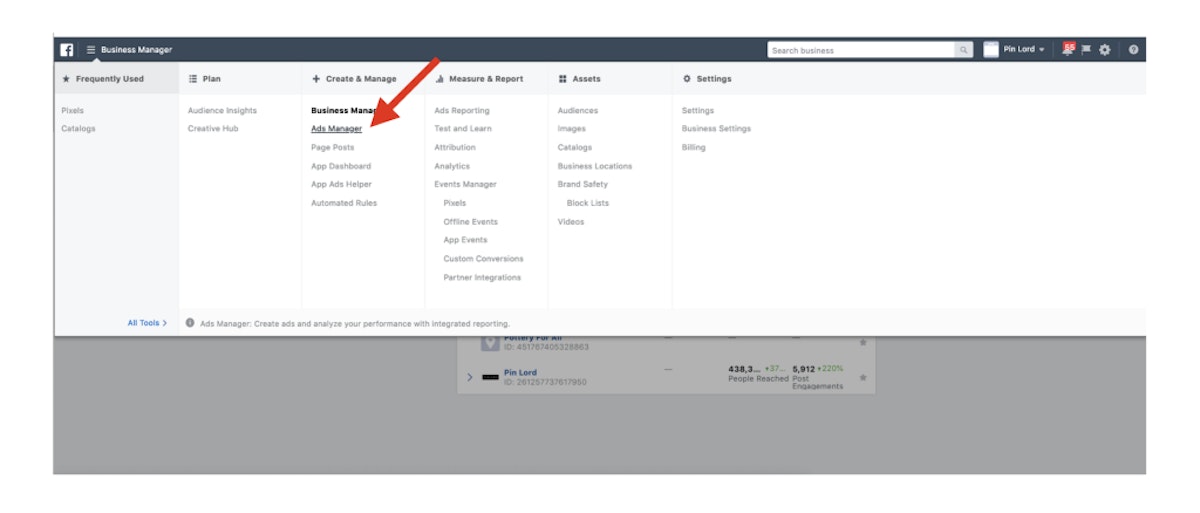
- Once you’ve clicked on the “Create” button, select the Traffic option as your objective within the campaign screen:

- Scroll down name your campaign and input the lowest possible Daily Budget (currently, that’s $5 per day) and hit Continue.
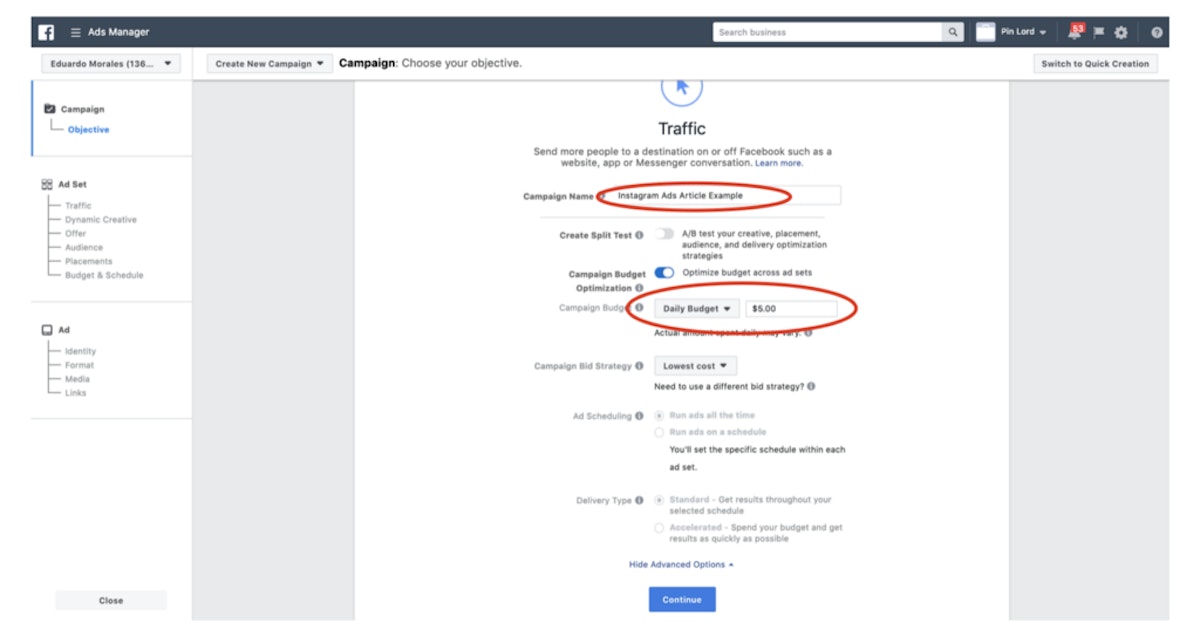
- Now that you’re in the Ad Set page, select the “Website” option (this is usually default) in the Traffic box and then scroll down to the Audience box. Here’s where you select your widest applicable audience. There will likely be one already selected for you (in my case it’s United States since I live there) but just “x” out of that one and search for the largest region that’s applicable for you. In @pinlord’s case, I ship internationally, so my largest applicable audience is “Worldwide”. If you ship internationally or have a widely-available digital product, this is likely to be the widest audience option for you. Some other options are “North America”, “Europe”, “Asia”, etc. What you’re going for are regions larger than countries. Whichever one is best for you will really depend on your business.
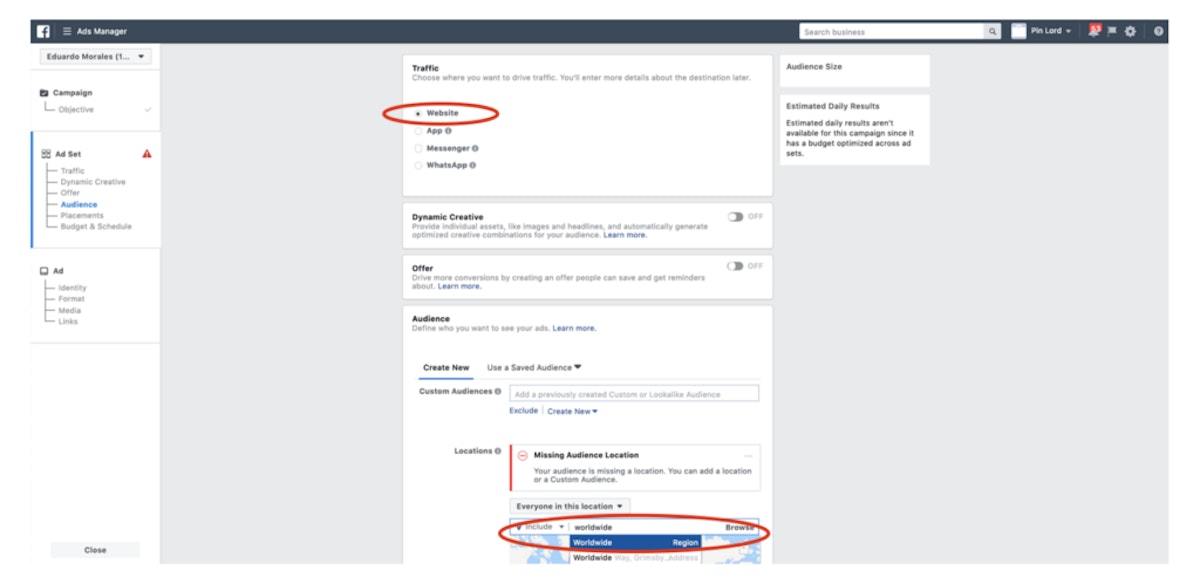
- Once you have your audience area down, select the broadest age and gender applicable demographics. In my case, it’s 18–65 without gender specifics (I’m lucky that pins are usually bought by all genders).

- Now that you’re done with your audience, scroll down to find the “Edit Placements” section. Here, un-tick all boxes and only leave the Instagram Stories boxed marked. This will make sure your Ad is only served as a story (this will greatly lower the cost and effectiveness of your Ad since you’ve made it specifically as a story).

- Once you’ve edited the placements, scroll down to the Budget & Schedule box. Here, schedule your Ad for a 15-day timeline (Ads usually start seeing their steepest decline in return after 15 days) and then change the “When You Get Charged” setting to Link Click (CPC). Scroll down and click Continue.
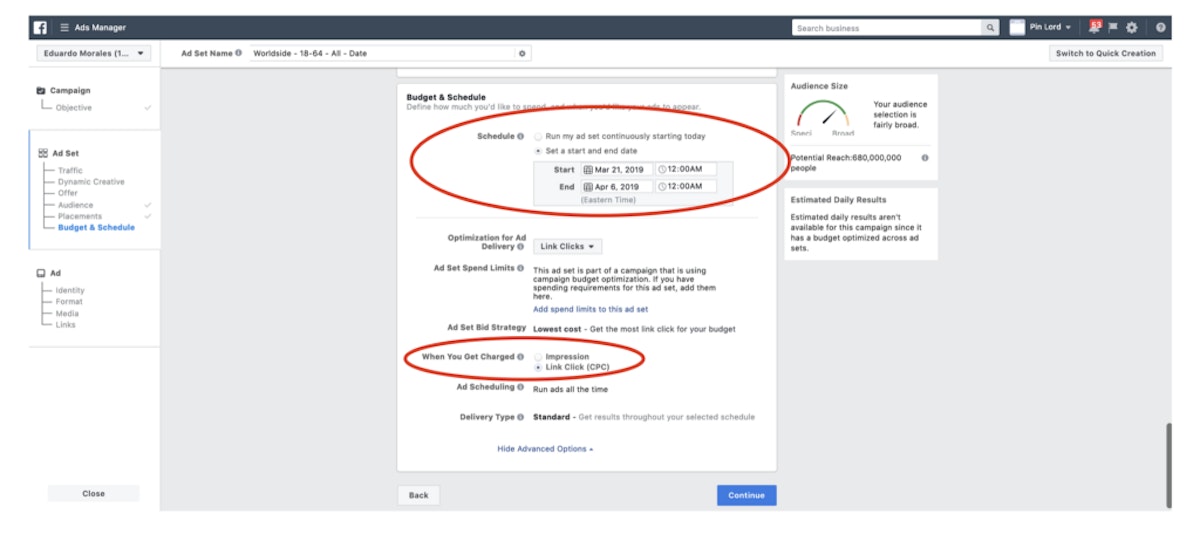
- You’re now in the Ad section of the process. Name your Ad at the top and then select the corresponding Facebook page and Instagram account you’ll run the Ad on. Also, select the Single Image or Video below.

- Now, upload your video and in the Links section, select Website. Below that in the Website Link, enter your Instagram URL. In my case, it’s https://www.instagram.com/pinlord/. You want to lead people to your Instagram instead of your website because you’ll gain more value here. If you have a differentiated, “sticky” account (this is why that part is so important), not only will people find your site through your link in bio and possibly buy, but you’ll also get a lot of new followers. This will give you thousands of more opportunities for any of these followers to buy something from you in the future in comparison to having initially led them to your website where they would land once and buy or not buy.
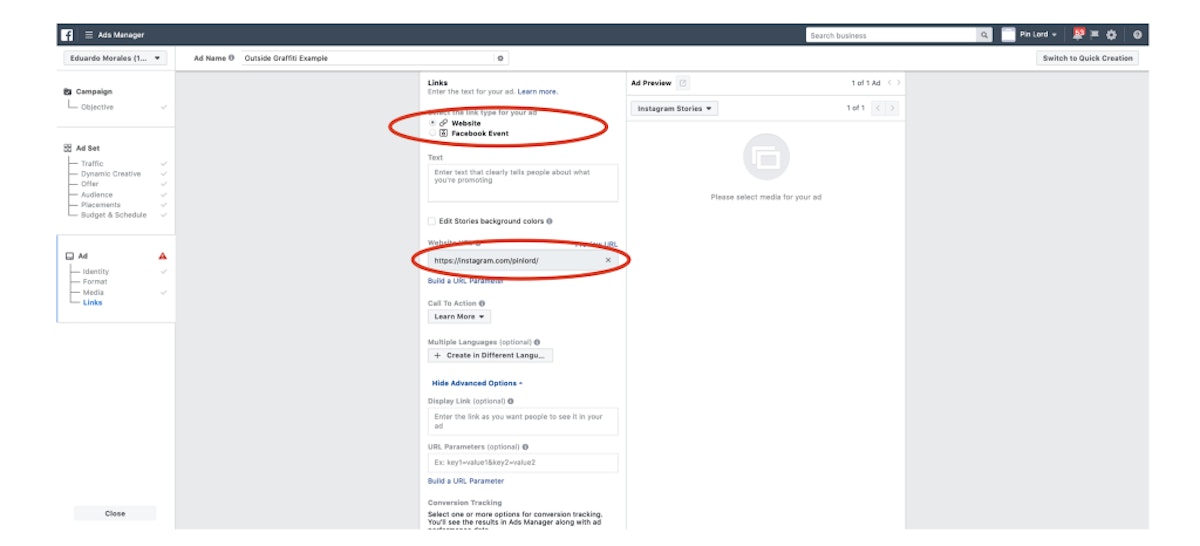
- Once you’ve done that, scroll to the bottom of this screen and click on CONFIRM. Congrats! Your Ad is now submitted for approval from Facebook and almost ready to go live.
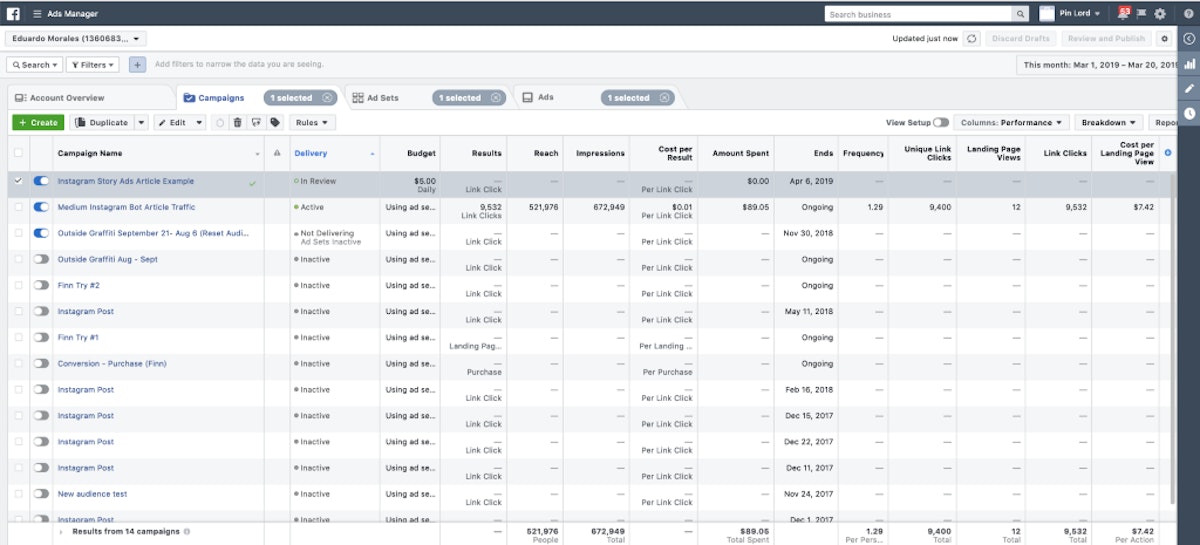
- Your Ad will show up as “in review” in your Ads manager dashboard until it’s approved by Facebook. Once it’s approved, it’ll start running (or run whenever you set the date for) and you’ll see it as “active” on the dashboard.
Repeat the process for the other two best, broadest and most applicable audiences.
- Now that you’ve run your Ad to the wides applicable audience, it’s time to repeat the exact same process. The only step that you’ll change is to target it to the 2nd and 3rd widest applicable audiences. In my case, it’s Asia and Europe.
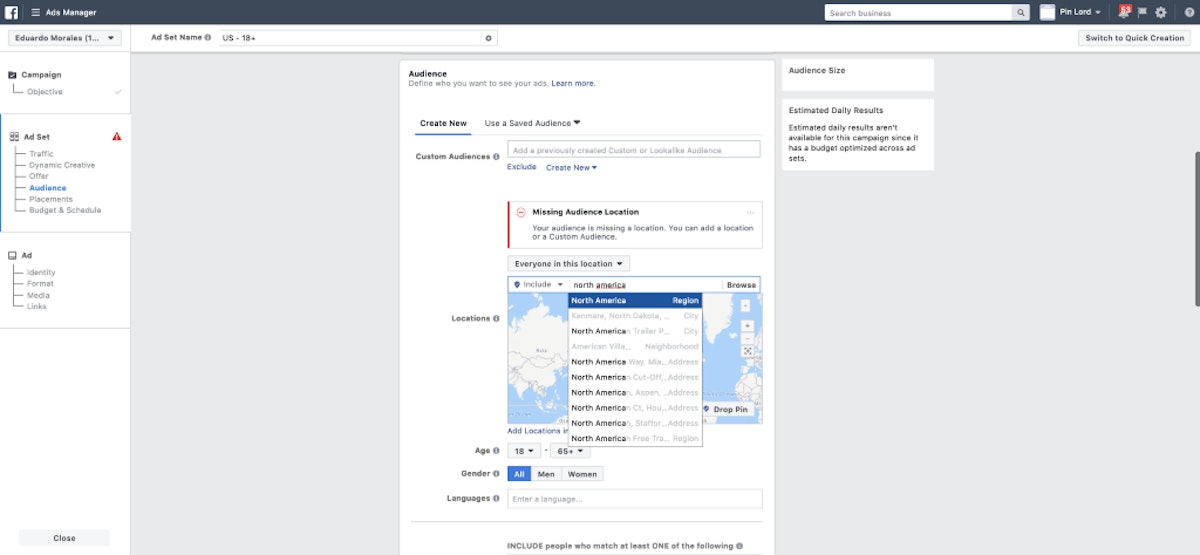

- By doing this, you’ll be serving the exact same Ad to 3 different audiences. This allows you to test the performance within those audiences to know which audience best responds to your Ad and content. This information is helpful because it’ll indicate which audience you should focus your Ad spend on in the future.
- Run the Ads for 3 full days and compare the CPC and Cost Per Page Landing View of each of the 3 audiences. In my case (below), the Ads targeted to Europe performed the best. Garnering a $.01 cpc and a $.06 cost per landing page view (Worldwide had a $.01 cpc and a $.10 cplpv & Asia a $.01 cpc and a $.12 cplpv)
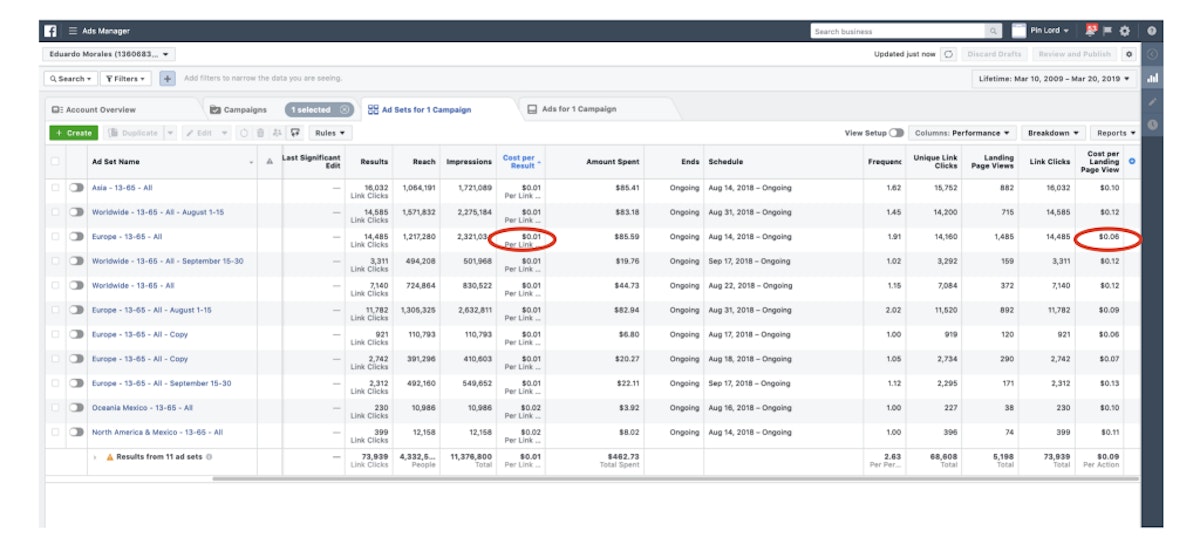
Note, these will all appear as running for you. I took these screenshots once these Ads had finished running.
Stop running all of the other Ads, duplicate the most cost-effective one and spend your money on the most cost-effective one for 2 weeks.
- Now that you’ve figured out which one of the three audiences gives you the best performance after day 3, stop running the Ads of the two worst performing audiences, and transfer that budget (if you have it) to two new Ads targeted to the audience that performed the best.
- To do this, select the “Duplicate” option under the audience that performed best. What you’re doing here is launching the exact same Ad to a different segment of that audience’s region, which means new people will see it but you’re much more likely to get that same high performance (level of performance of an Ad tends to vary much more from region to region but not within separate audience segments within a region).
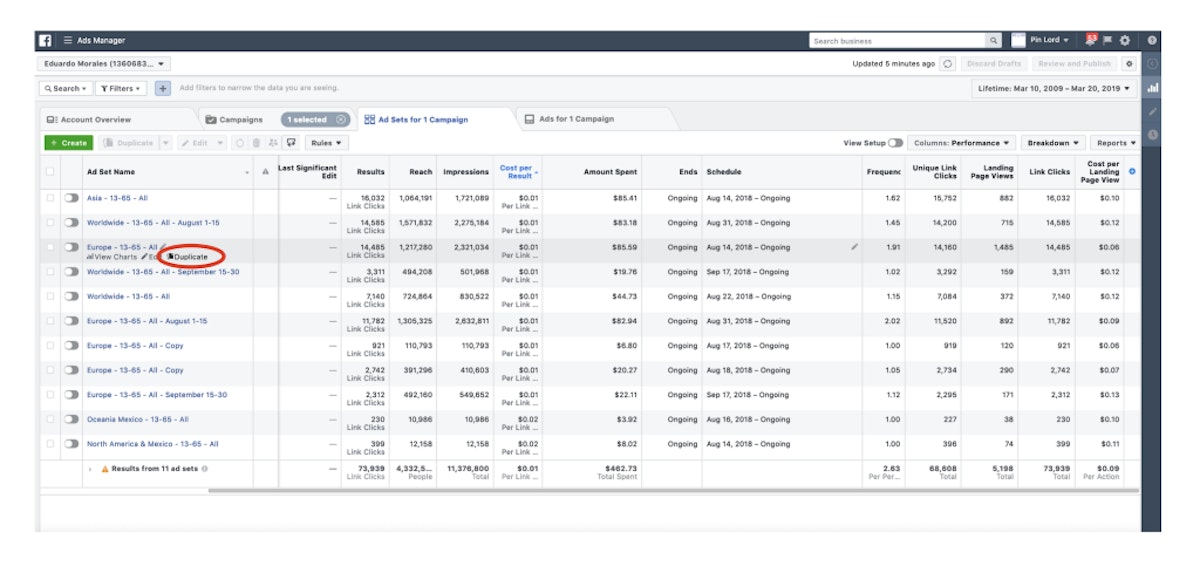
- Once you’ve duplicated the Ad twice, you’ll have a total of three Ads running at the same time to the same audience. It’ll look like the photo below.
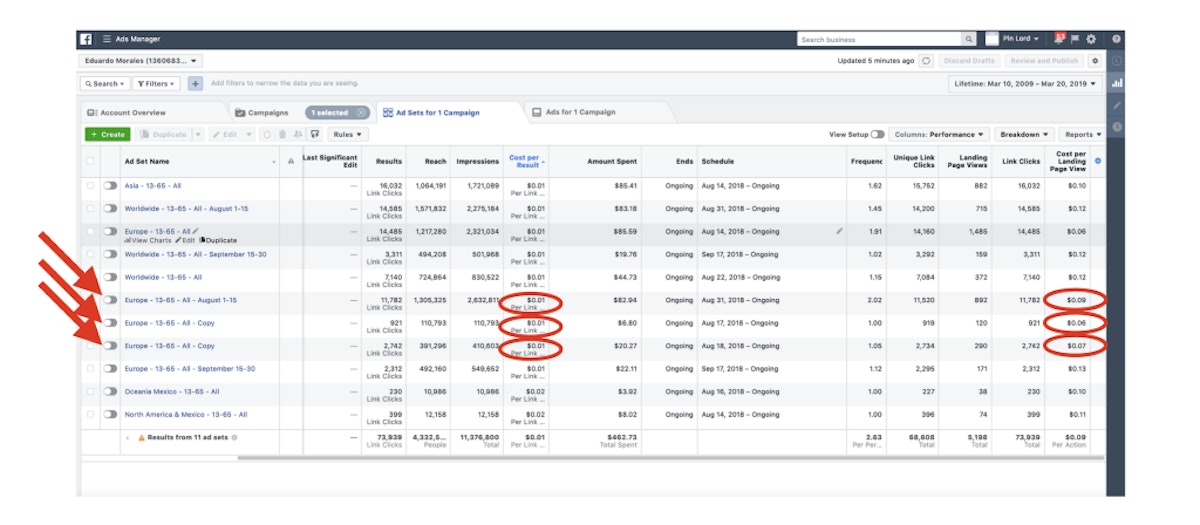
Note: these will all appear as “Running” for you. I took these screenshots once these Ads had finished running.
Boom! Done. You’re now running Instagram Ads.
Measure how many followers and sales it drives:
- Once you’ve had your Ads running for a week, measure their performance by checking how many new followers you gained (through your Instagram Insights) and how many new sales you received (through your e-commerce platform) in comparison to a week where you weren’t running Ads.
- To know if you should keep running the Ads, ask yourself: “Is the $105 ($5 per day x 3 Ads x 7 days) I just spent on Instagram Story Ads the cheapest way to gain the number of followers and sales I gained during the last week?” If the answer is yes, then keep running them. If the answer is no, spend your $105 in whichever marketing strategy gets you better results for that amount of money.
TEST and continue to improve:
If you believe in Instagram Story Ads and experienced enough positive results to feel like you want to get an even better return on your investment, the only way to do that is to continue testing your Ads. Try new audience targets, tweak your videos, and tweak your Instagram page! All of these elements influence how your audience responds to the Ads so the higher quality those elements are, the better your Ads will perform.
And don’t worry if this all appears confusing at first, just keep at it. No one ever became an Instagram Ads genius the first time they ran Ads. Testing consistently (and failing) is the only way to learn.
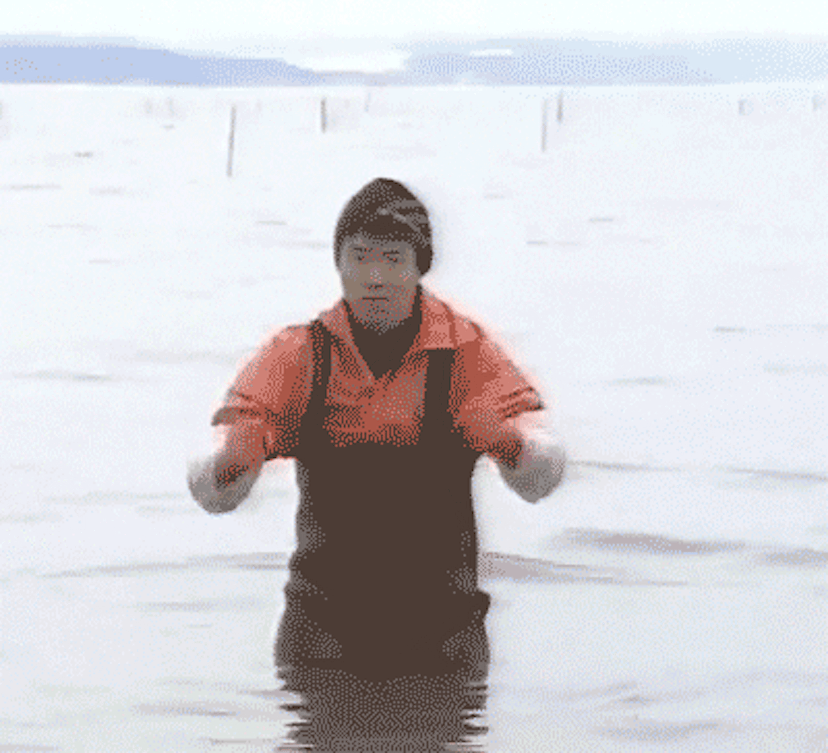
By the way, if you want to dive deeper into other strategies and systems to grow your Instagram faster, read these articles on how to grow your Instagram without buying followers. Then, you can tackle the following: how the Instagram algorithm works, how to make money on Instagram, the best Instagram bots, why your Instagram account isn’t growing, how to create effective Instagram story ads, how to create a visually appealing Instagram grid, how to increase your Instagram engagement, how to find the most valuable Instagram influencers, how to measure what an influencer is worth, how to measure your influencer marketing ROI, and how to reach out to influencers.
